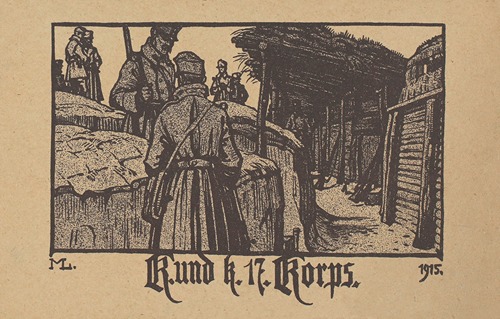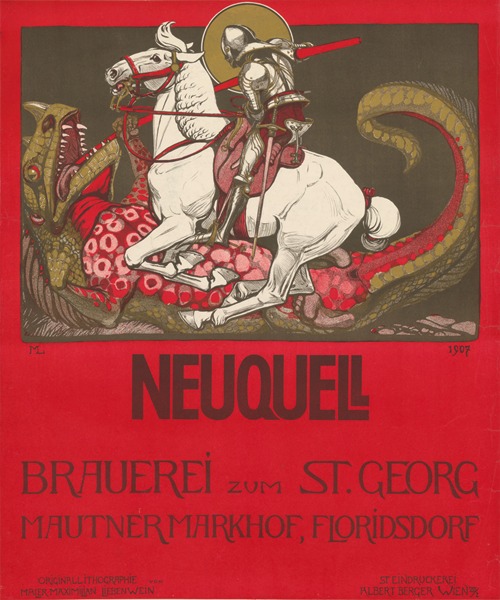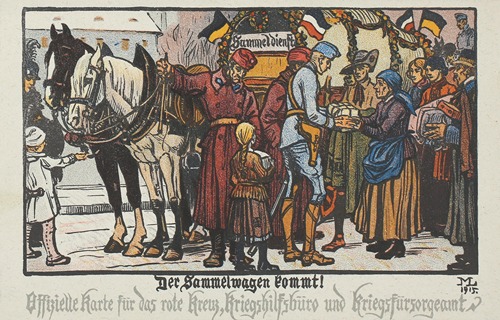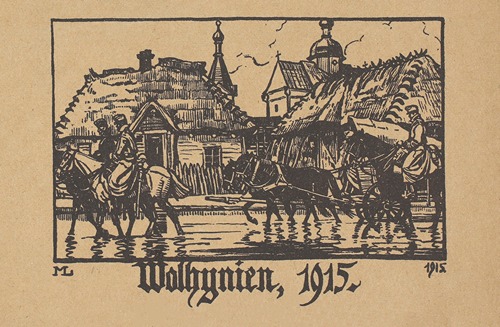

Maximilian Albert Josef Liebenwein was an Austrian-German painter, graphic artist and book illustrator, in the Impressionist and Art Nouveau styles. He spent significant time in Vienna, Munich and Burghausen, Altötting, and took an active part in the artistic community in all three places. He was an important member of the Vienna Secession, becoming its vice-president, and exhibiting with the group many times.
Liebenwein was born in Vienna, the second son of Joseph Calasanz Liebenwein (1835-1906) and Magdalena (née Kundrat). His father was a merchant, running a laundry and selling clothes in Vienna and in Lilienfeld. As a boy, Liebenwein spent time in both cities. His mother was the daughter of Joseph Kundrat [de], the personal valet of and a huntsman and forester for Emperor Franz Joseph, and his uncle was the pathologist and coroner Hans Kundrat. His grandfather kept a large library and a natural science collection, and helped fuel young Liebenwein's interest in poetry, legends and nature. Liebenwein studied at the Schottengymnasium in Vienna.
Liebenwein's father initially did not support his artistic ambitions, but his uncle helped smooth his path. In 1887 he entered the Academy of Fine Arts, Vienna, but he did not enjoy his studies there; he was keener to study animals at the Tiergarten Schönbrunn and cadavers under his uncle's supervision. Julius Victor Berger, Liebenwein's teacher, showed compassion to him, but he left the Academy in 1891. He spent 1891-92 with the 13th Dragoon Regiment, Prince Eugene of Savoy, then in autumn 1892 attended the Specialschule für Historienmalerei [de] (Special School for Historical Painting) under Matthias von Trenkwald. In 1893, he was appointed lieutenant of Reserve Dragoon Regiment Kaiser Franz I. Liebenwein's father broke his leg and needed help with the family business, and so Liebenwein could not attend classes regularly; this was a point of contention between von Trenkwald and Liebenwein, and he left the Special School in March 1893, spending several months as a "rider and hunter" on the Lilienfeld estate.
In 1894, he followed his friend Ferdinand Andri to Karlsruhe and enrolled at the Academy of Fine Arts, Karlsruhe and attended Caspar Ritter's painting classes. Still unhappy with his environs, he met Heinrich von Zügel in early 1895 and began attending his classes on animal painting. Liebenwein took to Zügel as a teacher, and, with him, moved to Munich in November. Liebenwein spent four semesters at the Academy of Fine Arts, Munich, matriculating on 12 November 1895 and staying there until 1897. His matriculation records list him as a Roman Catholic.
From 1897, Liebenwein lived as an independent painter in Munich, and also ran painting classes. During a visit with his draftsman/etcher friend Walter Ziegler, they saw Burghausen and the medieval Burghausen Castle. The medieval town of Burghausen and its castle impressed them as an appropriate conceptual setting for the romantic-chivalric themes of many of Liebenwein's works. The location had been suggested by Liebenwein's friend Ignatius Taschner, whom he had met in the Verein Deutscher Kunststudierender [de]. During the summers of 1897 and 1898 Liebenwein stayed at the castle. In 1899, Liebenwein established his residence and studio in the castle's largest tower, which he reworked as a Gesamtkunstwerk (total artwork) together with his friend Paul Horst-Schulze. Within three days in 1899, Horst-Schulze and Liebenwein painted a frieze inside the tower, so that Liebenwein's bride-to-be would see it on her first visit. The artwork covers three sides of a room and reflects medieval themes, including imagery of Walther von der Vogelweide and Parzival.
It was in this period that Liebenwein discovered his affinity for Art Nouveau; in 1896, some of his illustrations had appeared in the Art Nouveau magazine Jugend. He contributed to the Bosnian magazine Nada, from its founding in 1895 until its last issue in 1903. It was an initiative of Béni Kállay. Liebwein, the magazine's main illustrator Ewald Arndt Čeplin, his brother Leo and its other regular artist Ivana Kobilca formed the obscure 'Sarajevo Painter's Club'. He visited the country in 1900 and 1901.
In 1900, he won a competition held by Ludwig Stollwerck [de] for designs for a trading card album for the Stollwerck company. Other winners included Fritz Helmuth Ehmcke from Berlin; Ernst Neumann [de], Adolf Höfer [de] and Walter Püttner [de] from Munich; and Karl Hölle [de] from Hamburg. The judges were Emil Doepler, Woldemar Friedrich, Bruno Schmitz and Franz Skarbina from Berlin, in addition to a Stollwerck partner. Liebenwein's theme was Kater Murr.
Liebenwein exhibited with the Vienna Secession in spring 1900. His works shown included Percival (1899) and several animal studies. Following the exhibition, he became a full member of the group, and became its vice-president by 1912. He was an active member until his death. Still living in the 'Liebenwein tower' of Burghausen Castle, he married Anna Essigmann (born 1879), from Vienna, in May 1901, with his first son Hans Georg born in 1902 (died 1977). The family were friends with Koloman Moser, who had been on the committee that invited Liebenwein to exhibit with the Vienna Secession. Extracts from his travel diaries from his 1900 trip to Bosnia, together with his own illustrations, were published in Ver Sacrum in 1902. Liebenwein did not follow Gustav Klimt in seceding from the Secession in 1905, even though he was invited to join.
Liebenwein joined the Deutscher Künstlerbund in Weimar in 1904. After his father's death in 1906, he spent some time in Vienna, and in the same year made trips to Brussels and London. He joined the Luitpold group [de] in Munich in 1907; he exhibited in the Glass Palace between 1902 and 1912. During 1907–08, he created the Liebenweinfries (Liebenwein Frieze) in the Linz Savings Bank [de]. In 1909 received the Golden State Medal [de] in Graz for his fairy tale cycle King Thrushbeard (1905/06).
Liebenwein returned to Vienna in 1908-09, and ran a painting school for men and women until 1913, though he still spent summers in Burghausen. In 1910 he adorned a hall of the First International Hunting Exhibition in Vienna with monumental paintings; he was presented to Emperor Franz Joseph I at the exhibition.
His second son, Wolfgang Ferdinand, was born in 1911. Liebenwein volunteered for military service in 1914 and he was called up in June 1915; his wife Anna died from breast cancer in that year, in a sanatorium in Gmunden, while he was at the eastern front. Liebenwein served as an ordnance officer for XVII Corps. He was with the army in Poland, Russia, Isonzo and Bukovina, and produced many drawings in 54 sketchbooks. He suffered a stroke in December 1917, and left the army in December 1918.
Post-war Vienna did not offer many opportunities for artists, and Liebenwein moved back to Burghausen. In 1919–1925, he created a long cycle depicting the life of the Virgin Mary in the convent of the Franciscan Sisters of Vöcklabruck [de]. In 1923, he was a founding member of the Innviertler Artists Guild [de]. In 1924, Liebenwein received the Silver Medal of the city of Salzburg for the paintings "Und wenn die Welt voll Teufel wär..." (1908), "Christ and the Adulteress" (1914) and "Rider Troop in Ambush" (lost).
In February 1926, Liebenwein suffered another stroke in Burghausen, and died in July 1926 in Munich. He was buried in Burghausen.




